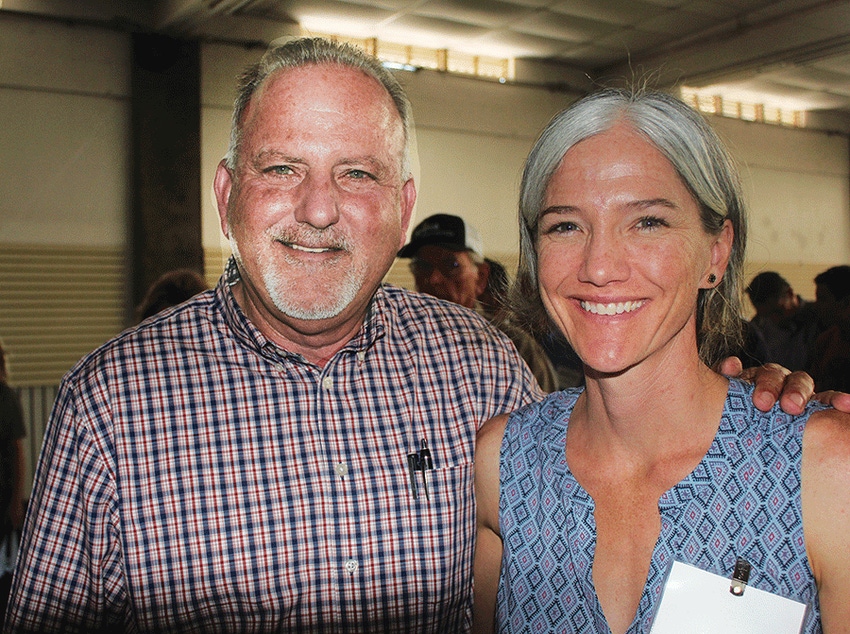July 3, 2018

This summer’s navel orangeworm (NOW) threat to almond and pistachio orchards could rival that of 2017, when damage to almonds by the pest was at historic levels, a biotechnology expert says.
Brad Higbee, field research and development manager for Trece Inc., a biotechnology company specializing in insect pheromone and kairomone products, outlined the situation at an Almond Day presentation at Fresno, Calif. Formerly director of entomology research at Wonderful Orchards, he has been a stalwart in efforts to thwart the pest.
NOW damage in 2017 was the highest since 2006 in many orchards, with heavy pressure coming on later, with third or fourth flights. He believes the NOW threat in 2018 may be similar to last year.
“Monitoring is able to give some warning,” he says, “but growers must be able to respond rapidly.”
MONITORING AND TRAPPING
Monitoring and trapping are keys in the battle against the pest. Weapons in the arsenal include pheromone lures, almond and pistachio mummy baits, phenyl propionate lures that attract males and females, and a synthetic kairomone that is under development.
It’s important, Higbee says, to monitor for the pest when the first nuts split, typically on the southern edges of orchards. Nuts should be collected from both upper and lower canopies and checked for NOW infestation. The percentage of infested nuts should be recorded at each location that is checked.
Monitoring can determine whether treatment is needed and which areas are at the greatest risk.
Sanitation is also a key in battling the pest. Mummies left on the ground or in trees become welcome homes for the pest. “They go where life is good,” Higbee says, “and life is good inside an almond.” Mating disruption has the greatest value in more challenging settings; biocontrols, however, have limited potential.
NOW is highly mobile and able to travel more than a half mile in one night, he notes.
The insecticide arsenal is limited, and includes bifenthrin, lambda-cyhalothrin, and fenpropathrin.
GROWTH REGULATORS
Insect growth regulators include methoxyfenozide and diflubenzuron. Organophosphates include Imidan and Lorsban, which is not registered in pistachios. There are also bacterial fermentation products, and derivatives including spinetoram, and a class of insecticides called anthranilic diamides, including chlorantraniliprole.
Lab assays have shown a degree of resistance development to bifenthrin, but trials in 2007 showed one application typically resulted in damage reduction between 80 percent and 95 percent, Higbee says. Another in 2014 included two to three applications that resulted in 45 percent to 55 percent damage reduction. A study of Air-O-Fan spray coverage showed the tops of trees received less coverage than the bottoms.
In another study, some nuts were dipped in a pesticide. While the dipping afforded some protection, a percentage became infested. But dipping resulted in a 92 percent reduction in damage.
Research on spray coverage showed PTO-based machines appear to be as effective as those that are engine driven. Cone-jet nozzles did not provide any significant advantage at 2 mph, but may have potential at high speeds. Higbee says the Progressive Ag tower continues to be a top performer, but not significantly better than standard Air-O-Fan machines.
The later the spray, the greater the impact, he says. “The prime time for applications is about 10 days to 6 days prior to harvest.” There has not been a new worm insecticide released in more than 10 years.
A PROVEN BENEFIT
Mating disruption has shown to be a proven benefit in almonds, and more recently in pistachios, Higbee says. “A 50 percent damage reduction is the expectation,” he notes, adding that there has been a steep incline in adoption of mating disruption in the past five years.
The cost for mating disruption is $120 to $160 per acre. For insecticide application it’s $40 to $60 per spraying. New delivery technologies could add efficiency and flexibility to current puffer systems, Higbee says.
Foreign markets are driving down acceptable NOW damage levels, and pyrethroid performance is waning, he notes. He believes heavy pressure areas will require multiple applications of ovi-larvicides, plus mating disruption. Lower pressure areas can be controlled with mating disruption or one or two sprays. “Combining insecticides with mating disruption results in the lowest damage in all situations.”
Low-to-moderate pressure situations can still be managed, Higbee says, but high pressure situations will require the most inputs, and there is no guarantee that an expectation of 1 percent to 2 percent NOW damage can be achieved.
Sanitation, while costly, is likely the most effective intervention “until futuristic technologies overcome the need,” he says.
You May Also Like




